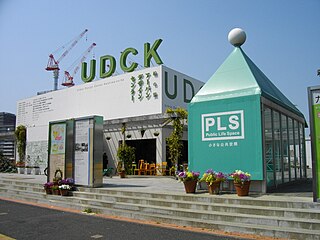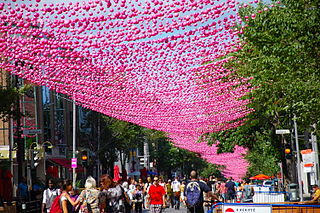
Sustainable development is the organizing principle for meeting human development goals while at the same time sustaining the ability of natural systems to provide the natural resources and ecosystem services upon which the economy and society depend. The desired result is a state of society where living conditions and resource use continue to meet human needs without undermining the integrity and stability of the natural system. Sustainable development can be classified as development that meets the needs of the present without compromising the ability of future generations.

Urban design is the process of designing and shaping the physical features of cities, towns and villages and planning for the provision of municipal services to residents and visitors. In contrast to architecture, which focuses on the design of individual buildings, urban design deals with the larger scale of groups of buildings, streets and public spaces, whole neighborhoods and districts, and entire cities, with the goal of making urban areas functional, attractive, and sustainable.
Public art is art in any media that has been planned and executed with the intention of being staged in the physical public domain, usually outside and accessible to all. Public art is significant within the art world, amongst curators, commissioning bodies and practitioners of public art, to whom it signifies a working practice of site specificity, community involvement and collaboration. Public art may include any art which is exhibited in a public space including publicly accessible buildings, but often it is not that simple. Rather, the relationship between the content and audience, what the art is saying and to whom, is just as important if not more important than its physical location.
Architecture for Humanity was a US-based charitable organization that sought architectural solutions to humanitarian crises and brought professional design services to clients. Founded in 1999, it laid off its staff and closed down at the beginning of January 2015.
Sustainable cities, urban sustainability, or eco-city is a city designed with consideration for social, economic, environmental impact [1][1], and resilient habitat for existing populations, without compromising the ability of future generations to experience the same. These cities are inhabited by people whom are dedicated towards minimization of required inputs of energy, water, food, waste, output of heat, air pollution - CO
2, methane, and water pollution. Richard Register first coined the term "ecocity" in his 1987 book, Eco city Berkeley: Building Cities for a Healthy Future. Other leading figures who envisioned the sustainable city are architect Paul F Downton, who later founded the company Ecopolis Pty Ltd, as well as authors Timothy Beatley and Steffen Lehmann, who have written extensively on the subject. The field of industrial ecology is sometimes used in planning these cities.
Sustainable landscape architecture is a category of sustainable design concerned with the planning and design of outdoor space.

The University of Notre Dame School of Architecture was the first Catholic university in America to offer a degree in architecture, beginning in 1898. The School offers undergraduate and post-graduate architecture programs.

UrbanLab is an American architecture and urban design firm headquartered in Chicago. Founded by Martin Felsen, FAIA and Sarah Dunn in 2001, the office is known for its focus on sustainability, creative experimentation and a collaborative approach to buildings, spaces and cities.
A smart city is an urban area that uses different types of electronic Internet of things (IoT) sensors to collect data and then use these data to manage assets and resources efficiently. This includes data collected from citizens, devices, and assets that is processed and analyzed to monitor and manage traffic and transportation systems, power plants, water supply networks, waste management, crime detection, information systems, schools, libraries, hospitals, and other community services. The smart city concept integrates information and communication technology (ICT), and various physical devices connected to the IoT network to optimize the efficiency of city operations and services and connect to citizens. Smart city technology allows city officials to interact directly with both community and city infrastructure and to monitor what is happening in the city and how the city is evolving.
Architectural design values make up an important part of what influences architects and designers when they make their design decisions. However, architects and designers are not always influenced by the same values and intentions. Value and intentions differ between different architectural movements. It also differs between different schools of architecture and schools of design as well as among individual architects and designers.
Urban Interventionism is a name sometimes given to a number of different kinds of activist design and art practices, art that typically responds to the social community, locational identity, the built environment, and public places. The goals are often to create new awareness of social issues, and to stimulate community involvement. Such practices have a history that includes certain street artists of the 1960s, such as The Diggers of San Francisco, or the Provos of Amsterdam, among many others.

Pop-up retail, also known as pop-up store or flash retailing, is a trend of opening short-term sales spaces that started in Los Angeles and now pop up all over the United States, Canada, China, Japan, Mexico, France, Germany, the United Kingdom and Australia. The pop-up industry is now estimated to be a $50 billion industry. Pop-up retail has been an increasing factor during the retail apocalypse of the 2010s, including seasonal Halloween retailer Spirit Halloween, who has operated stores in vacant spaces during the season.
Environmentally sustainable design is the philosophy of designing physical objects, the built environment, and services to comply with the principles of ecological sustainability.

Urban acupuncture is a socio-environmental theory that combines contemporary urban design with traditional Chinese acupuncture, using small-scale interventions to transform the larger urban context. Sites are selected through analysis of aggregate social, economic and ecological factors, and are developed through a dialogue between designers and the community. Just as the practice of acupuncture is aimed at relieving stress in the human body, the goal of urban acupuncture is to relieve stress in the built environment. In Taipei, there was an urban acupuncture workshop that aimed to "produce small-scale but socially catalytic interventions" into the city's fabric.
Public interest design is a human-centered and participatory design practice that places emphasis on the “triple bottom line” of sustainable design that includes ecological, economic, and social issues and on designing products, structures, and systems that address issues such as economic development and the preservation of the environment.

Tactical urbanism is a type of low-cost, temporary changes to the built environment, usually in cities, intended to improve local neighbourhoods and city gathering places. Tactical urbanism is also commonly referred to as guerilla urbanism, pop-up urbanism, city repair, or D.I.Y. urbanism.

Urban planning is a technical and political process concerned with the development and design of land use and the built environment, including air, water, and the infrastructure passing into and out of urban areas, such as transportation, communications, and distribution networks. Urban planning deals with physical layout of human settlements. The primary concern is the public welfare, which includes considerations of efficiency, sanitation, protection and use of the environment, as well as effects on social and economic activities. Urban planning is considered an interdisciplinary field that includes social, engineering and design sciences. It is closely related to the field of urban design and some urban planners provide designs for streets, parks, buildings and other urban areas. Urban planning is also referred to as urban and regional planning, regional planning, town planning, city planning, rural planning, urban development or some combination in various areas worldwide.
Mary Ann Jackson is an architect, planner and access consultant from Melbourne, Australia. Jackson is the owner of Visionary Design Development Pty Ltd an access consultancy business in North Melbourne specialising in universal design and sustainably accessible environments. Her professional career spans architectural roles firstly as a student architect in a small firm in Perth, Senior Architect at Gray Puksand Pty Ltd and Principal at MAG Designs, Architecture and Interior Design. Her current business, Visionary Design Development founded in 2005 by Jackson and her husband, vision scientist Ralph J. Green. The practice has a social justice commitment, works on housing projects with the Department of Human Services and recently began a pro bono studio arm with students and international architects living in Melbourne. Much of their work centres in the integration of health care and construction, the provision of specialist advice in researching, planning, designing and developing healthy cities and communities. A pilot study of a Universal Mobility Index is creating much interest both locally and abroad with governments and disability groups.

The Gates Vascular Institute and the University at Buffalo‘s Clinical and Translational Research Center is a 10 story building at 875 Ellicott St, Buffalo, New York. The Institute is next to Buffalo General Medical Center and opened on May 24, 2012. The building was designed by Mehrdad Yazdani of CannonDesign and offers services for stroke care, cardiac surgery, and vascular services. Project costs were approximately $290,000,000.










